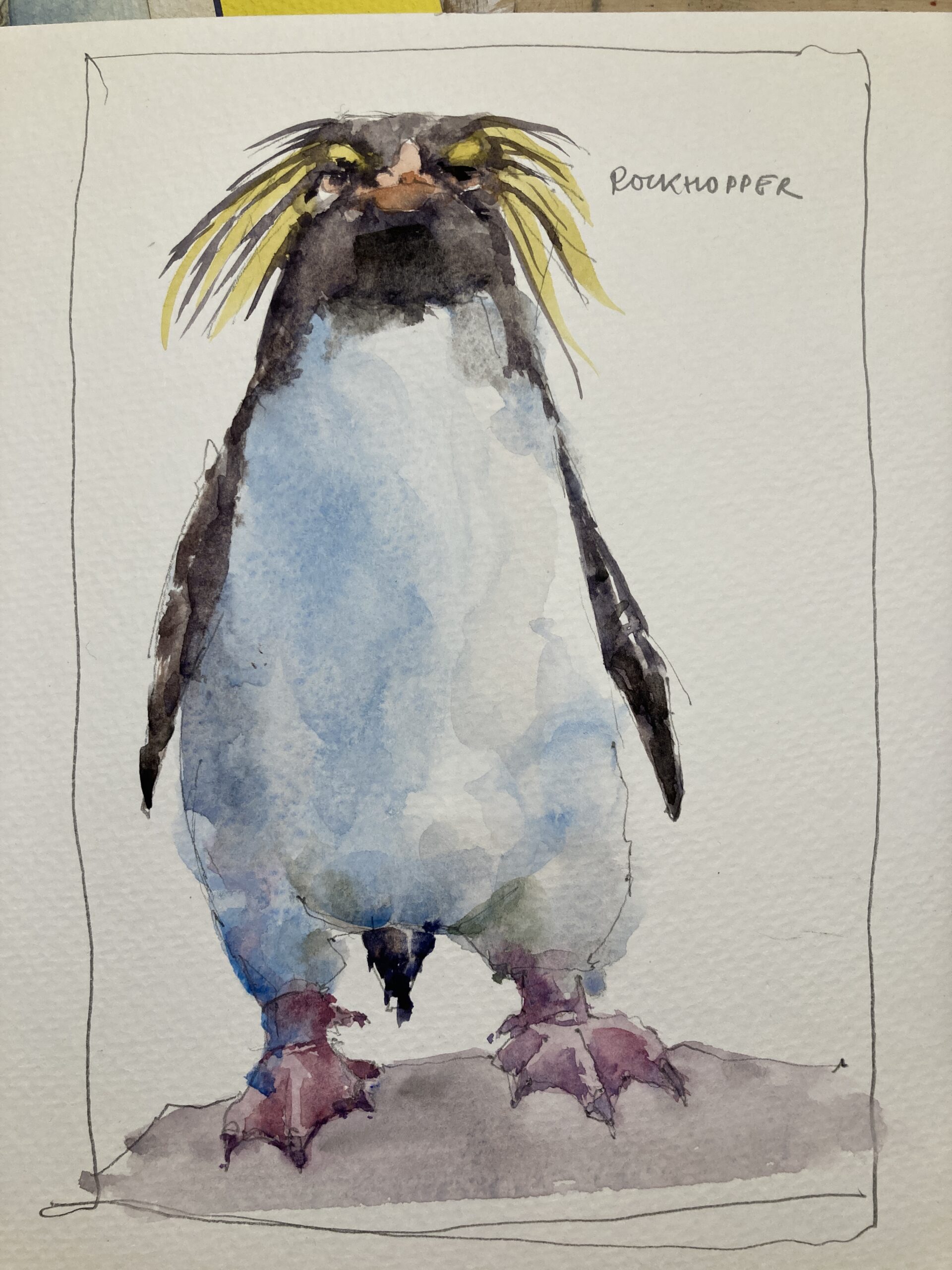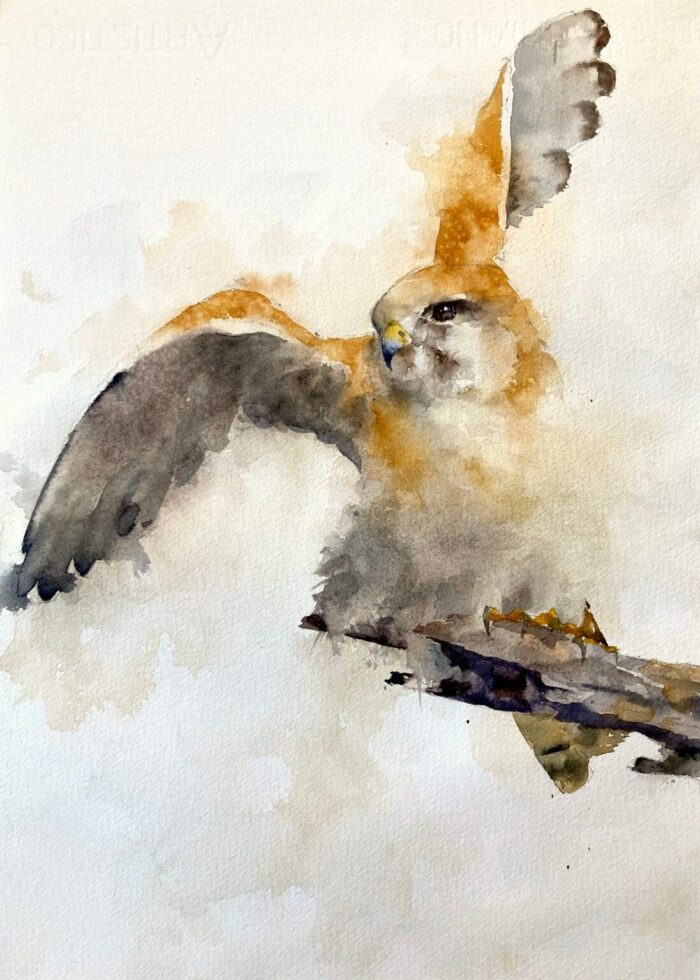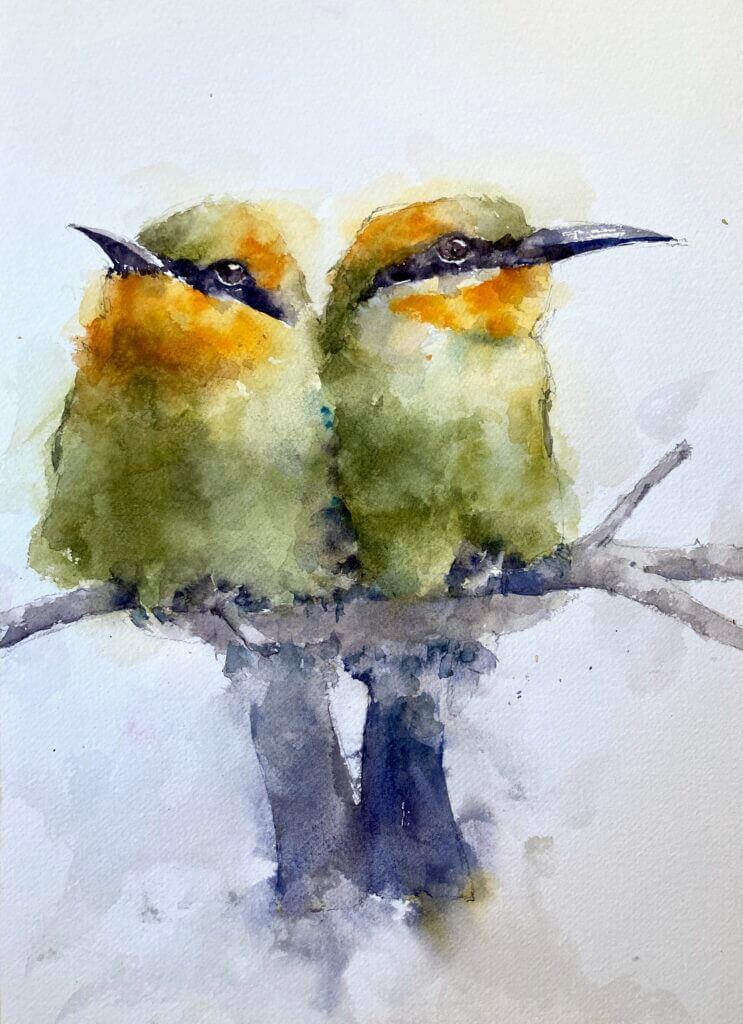Penguin watercolor sketches and a complete watercolor penguin painting. Ideas for how to make penguin painting easy.

So penguin watercolor sketches are the topic for today. The reason for this is that I’ve had a commission on the todo list for a while now. Specifically it is for a panoramic penguin painting featuring multiple species of penguins. James has requested it and the final painting will hang in our main living room. It’s going to be a challenge.
Are Penguins Good for Beginner Watercolor Paintings?
Penguins are great for beginners watercolor painting. They are fairly easy to draw and quite forgiving if you don’t get complete accuracy. When it comes to the painting the penguin coloring really helps us. They have wonderful white bellies with very dark wings and back. This high contrast helps us when painting – we don’t have to hit really accurate values to get a convincing penguin painting. So if you’re looking for beginner watercolor ideas (or even if you’re a seasoned pro!) penguin watercolors are for you!
Watercolor Supplies Needed
You don’t need too many supplies for a basic watercolor kit. Some paper, a brush and some paint. However there are a lot of options to choose from. Below I give you my preferences and some more budget options for a beginner watercolor set.
Watercolor paper for our Watercolor Penguins
First and foremost we need some paper. It’s the most important thing to make watercolor painting easier. However the best watercolor paper i.e. 100% cotton paper is not cheap. I tend to use Fabriano Artistico 140lb cold press. It’s a great paper and you can get some good deals on it from cheapjoes.com or Jerry’s Artarama. A lot of people swear by Arches watercolor paper. It is a great paper and especially if you’re beginning watercolor painting. However it is a little more expensive. For the sketches a student grade paper is fine. I like the Fabriano ‘fat’ pad which is 25% cotton and takes paint reasonably well. I also use a Strathmore watercolor sketchbook which, although not as good as the Fabriano, is a good choice.
Best Watercolor Brush
Brushes are the next most important thing for your penguin watercolor. The absolute best watercolor brushes are made from Kolinsky sable and are eye-wateringly expensive. However, all is not lost! There are a number of really good synthetic brushes available that come close to that sable experience. For the best synthetic watercolor brush I like the Princeton Aqua Elite and the Escoda Reserva brands. I’ve also recently used the Silver Black Velvet brushes which have a nice feel to them.
Whichever brand you go with you’ll need around a size 10 round and it should come to a good point when wet and hold a good amount of water.

Online Zoom Classes
I run online zoom courses regularly for both beginners and more advanced students. Please check out my workshop page.
Best Watercolor Paints for our Penguin Watercolor
The watercolor paint you use is less important than the paper. Pretty much any quality artist watercolor paint will work well and most of the student brands too (e.g. Lukas Studio, Winsor & Newton Cotman). Even something like the Artists Loft watercolor tubes will be fine for some sketches.
Colors needed:
- Ultramarine Blue or cobalt blue watercolor paint.
- Cerulean blue (not absolutely essential but I like the way it granulates)
- Burnt Sienna
- Cadmium orange (or a red and a yellow so you can make orange)
First things first – start off with some sketches to see how the different penguins look.
Miscellaneous Watercolor Supplies
- Mechanical pencil for the penguin drawing
- Masking tape to tape our paper to a board (not needed if you’re using a watercolor block)
- Spray bottle to keep our paint moist.
- Palette with large white mixing areas (a white plate can suffice in a pinch).
- Water and water pot
- Paper towels.
So that’s the watercolor painting kit dealt with. Let’s get back the penguins!
There are many different species of penguin
There are apparently 18 species of penguin. Some are more visually attractive than others so sorry, but the little Australian penguin probably won’t make the cut. Of them all the rockhopper sketch came out very well as did the gentoo sketch. I also found out that I’ve been painting king penguin watercolors and they’ve been painting an emperor penguin watercolor all this time. Silly me!
My approach was to pick a penguin and quickly get down the main shapes. I tried not to dwell too much on the drawing accuracy (within reason of course). Keeping the lines and shapes interesting was more important than accuracy. I took a couple of liberties with the penguin feet drawing. Not all penguins have orange feet but I like that pop of color so orange they were. One of the sketches that wasn’t quite as successful as the rest was the ‘unknown penguin’. I really liked the pose with the outstretched wing but the penguin plumage itself wasn’t particularly interesting. I may transplant the pose onto another species and see how that works.






You have to paint quickly on sketchbook paper
I was painting these fairly small (around 4 or 5 inches) in a Strathmore watercolor sketchbook. This isn’t the worst paper to paint on in the world but it’s no Arches or Fabriano Artistico. The paper is fairly substantial but not very absorbent. The paint dries quickly and blending is hard. This means that you have to work fast and not noodle over things too much. But it lends itself to a very loose and energetic style which I like for a watercolor sketch.
Next Steps for Our Penguin Watercolor
A watercolor penguin sketch makes for an enjoyable afternoon’s painting. The next step will be to compose them so they look interesting and not just pasted in a line.
Panoramic Penguin Watercolor Painting – The Study
The next day was time to get back to the penguin watercolor painting. I had a piece of paper ready cut but it had curled too much to paint on. So while I was waiting for it to flatten out overnight I used the offcut to do a quarter size test study. This is 6″x17″ and the final thing will be 32″x11/5″ which will be a pretty big scale up.
I’d done some sketching out of the composition on the ipad a couple of nights ago and was pretty happy. Everything is out of my head and from experience of previous paintings. I’m still wondering whether a few extra penguins will make their way in there but it hangs together pretty well so far.
First the drawing.
Looks ok so far. The shapes are good. There’s lots of overlapping shapes and the background cliffs tie everything together horizontally.
Now into the painting.
The sky went in ok. I was thinking of maybe masking the cliffs but in the end it wasn’t an issue. The darks of the penguins look good. Not a lot of detail here. All the work is being done by the shapes.
I’m pretty far along here. Everything went pretty straightforwardly. Just goes to show what a bit of planning can do. I’m still wondering whether to add in a couple more penguins on the right. And those two wings in the center two penguins are a little too similar so that might change.
And the final thing again
Vidoe of an Easy Watercolor Penguin Tutorial
If you’re interested in painting an easy penguin watercolor have a look at my youtube penguin painting tutorial below. It’s designed as a beginner watercolor tutorial so, if you try it, please let me know how you get on. And please subscribe to my YouTube channel if you’d like to see more demos in the future.

































